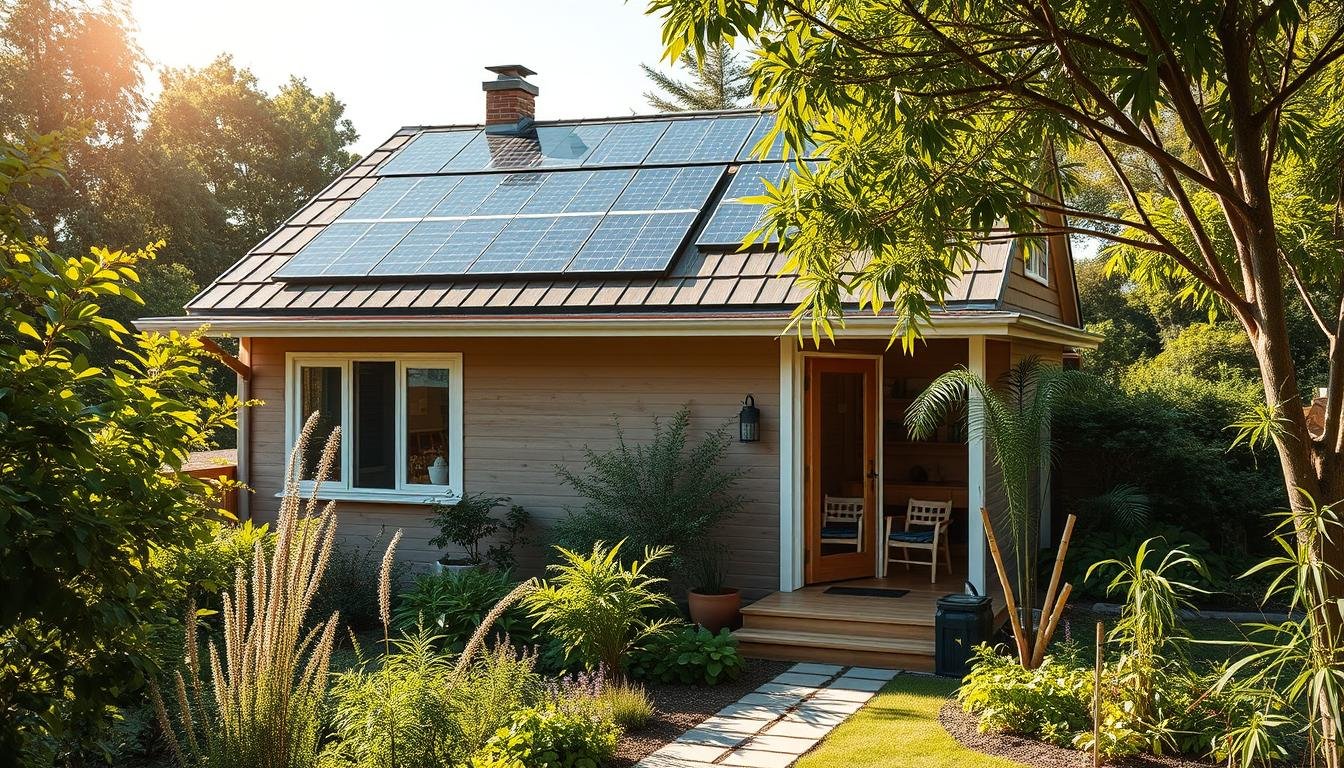Homeowners are now focusing more on making their homes sustainable and energy efficient. Simple changes like swapping out lightbulbs can be done in minutes. However more significant projects like new windows or a tankless water heater require more skill and money. Yet the benefits of these changes are worth it in the long run.
This article shares some of the best ways to make your home more Eco-Friendly Home Improvements top tips to try. You can start by using LED lights and better insulation. You can also get energy-saving appliances and think about solar power. These steps can turn your home into a greener more efficient place.
Essential Takeaways Eco-Friendly Home Improvements top tips to try
- Eco-friendly home improvements can result in considerable reductions in utility expenses and minimize environmental effects.
- Simple swaps like switching to LED lighting can be completed quickly while more complex projects require more substantial investment but offer long-term benefits.
- Upgrading insulation installing a tankless water heater and prioritizing energy-efficient appliances are among the top eco-friendly home improvement tips.
- Transitioning to solar power can provide homeowners with renewable energy and long-term cost savings.
- Sustainable renovations and green building materials should be considered for a more eco-friendly home.
Switch to LED Lighting
Switching to LED bulbs is a simple and cost-effective way to make your home more eco-friendly. It might cost more upfront than traditional bulbs. But they last much longer and save a lot of energy over time.
Energy Efficient and Long Lasting
This can save the average customer about $225 per year. They also last 25000 to 50000 hours much longer than incandescent bulbs.
This makes LED bulbs an intelligent choice for any eco-friendly home upgrade.
Versatile Applications: Indoors and Outdoors
LED bulbs work well in many places like kitchens and living rooms. They are also great for holiday lights and outdoor lighting. This lets you use energy-efficient lighting both inside and outside your home.
Their versatility and performance LED bulbs are essential for anyone who wants to lessen their impact on the environment.
The benefits of long-term savings and the favorable effects on the environment clearly make it a wise decision for any homeowner.
Upgrade Windows for Better Insulation
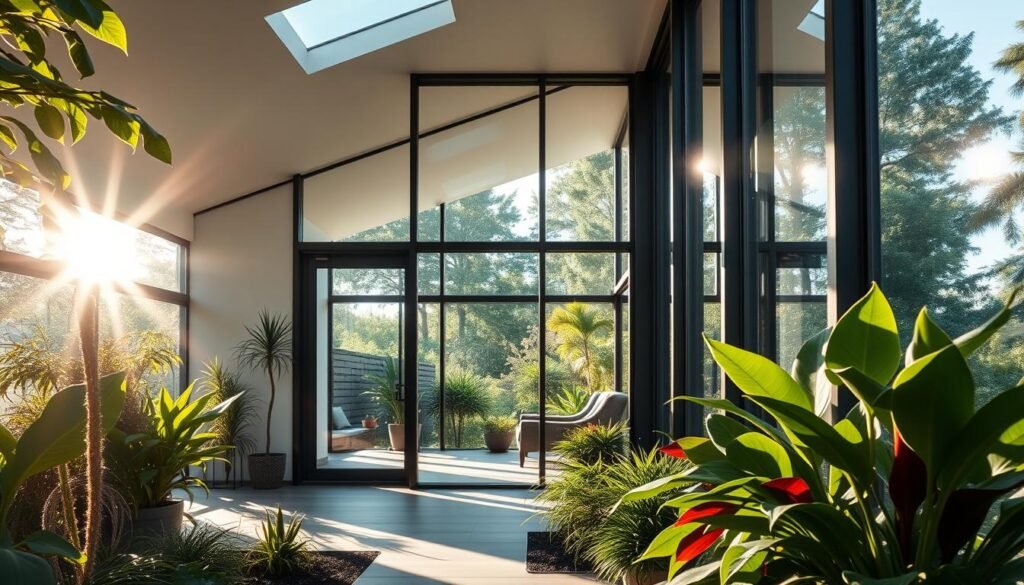
Drafty outdated windows can waste a lot of energy in your home. Did you know that according to the U.S. Department of Energy around 25 to 30% of the energy used for heating and cooling homes comes from windows? Getting new windows can make your home more comfortable and save you money in the long run.
When picking new energy-efficient windows look for the ENERGY STAR label and NFRC ratings. These ensure the windows fit your climate and needs well. Features like gas-filled panes and low coatings improve the ability of a window to keep heat in or out.
In cold areas choose windows with a low U factor for better insulation. In warm places pick windows with a low solar heat gain coefficient SHGC to block heat.
Getting your new windows installed right is key to saving energy. A professional can make sure they fit tightly and do not let air leak. With the right window upgrades and installation you can cut down your homes energy use and lower your bills for years.
Install a Tankless Water Heater
Many people who own homes want to find ways to use less energy and protect the environment.Installing a tankless water heater is a popular choice. These heaters heat water only when needed. Unlike regular water heaters that constantly keep water hot.This saves energy and money.
On-Demand Hot Water
Tankless water heaters do not need a big tank. This means you always have hot water without wasting energy.
Energy and Cost Savings
The U.S. Department of Energy says tankless heaters are 24% to 34% more efficient. This can save the average household $100 a year on energy bills. Plus they last 20 years or more longer than traditional heaters.
| Water Heater Type | Annual Energy Cost | Lifespan |
|---|---|---|
| Tankless | $150-$180 | 20+ years |
| Traditional Tank | $200-$300 (gas) $450-$500 (electric) |
8-15 years |
While tankless heaters cost more upfront they save money in the long run. They are a smart choice for those who want to save energy and water.
Update Plumbing Fixtures for Water Conservation
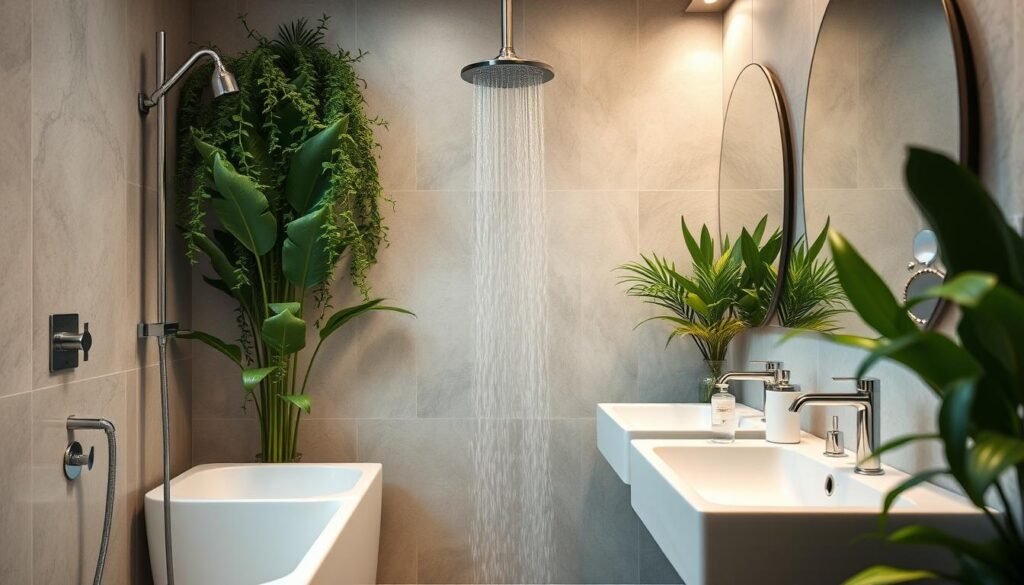
Homeowners often forget how much our plumbing fixtures affect water use and bills. But switching to water-efficient plumbing can cut down water use and lower bills over time.
Replacing old toilets with WaterSense models is a smart move. These toilets use 20% to 60% less water saving about $140 a year for each household.
Changing to low-flow fixtures in showers can save a family up to 2700 gallons of water yearly. For even more savings consider a steam shower which can save over 16000 gallons a year.
Updating faucets to water-efficient plumbing also helps save water. By using WaterSense faucets your family can save up to 700 gallons of water every year.
Not only is this good for the planet but it also boosts your home value. Buyers see updated water-saving systems as a sign of a well-kept home making it more appealing.
| Plumbing Upgrade | Water Savings | Annual Cost Savings |
|---|---|---|
| WaterSense Toilet | 20-60% reduction | $140 |
| Low Flow Showerhead | 2700 gallons | Varies |
| WaterSense Faucet | 700 gallons | Varies |
| Steam Shower | 16000 gallons | Varies |
By choosing water-efficient fixtures you can greatly reduce water use lower bills and help the environment.
Prioritize Energy Efficient Appliances
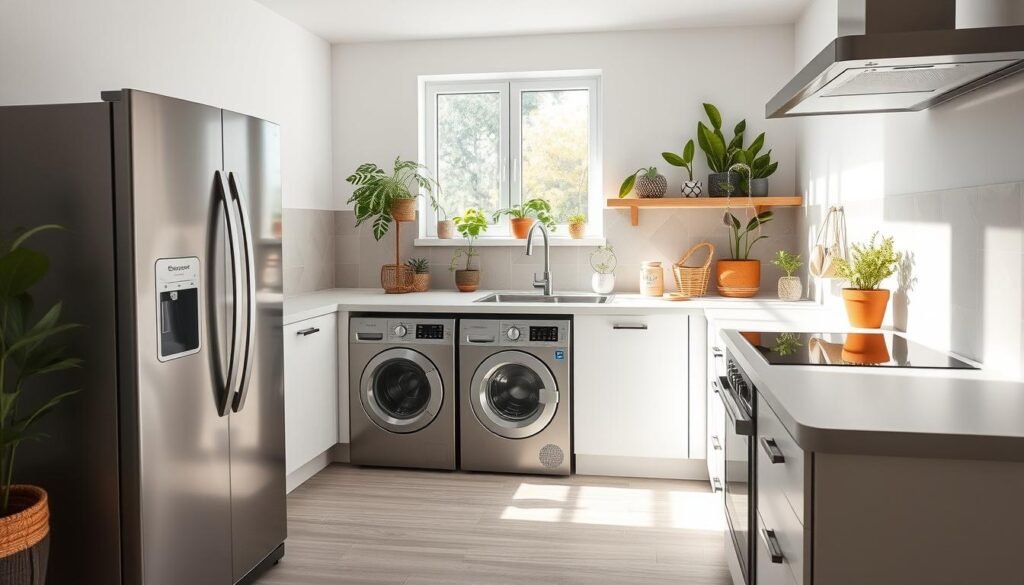
Choosing energy-efficient appliances is a wise move for eco-friendly home upgrades. Modern appliances now use less energy thanks to recent improvements. Look for Energy Star-certified appliances to save even more. These meet the U.S. Department of Energys high standards for energy use.
Even if you can not replace all your appliances at once there are steps you can take. Use smaller appliances when you can and cover pans while cooking. Also run full loads in your dishwasher and washing machine. These small changes can help cut down on energy use and lower your bills.
- Prioritize Energy Star-certified appliances for maximum energy efficiency
- Use smaller appliances when appropriate to save energy
- Cover pans while cooking to reduce heat loss
By focusing on energy-efficient appliances and making a few simple changes you can make your home more sustainable and cost-effective. These appliance upgrades are essential for an eco-friendly home.
Top eco-friendly home improvement tips to try
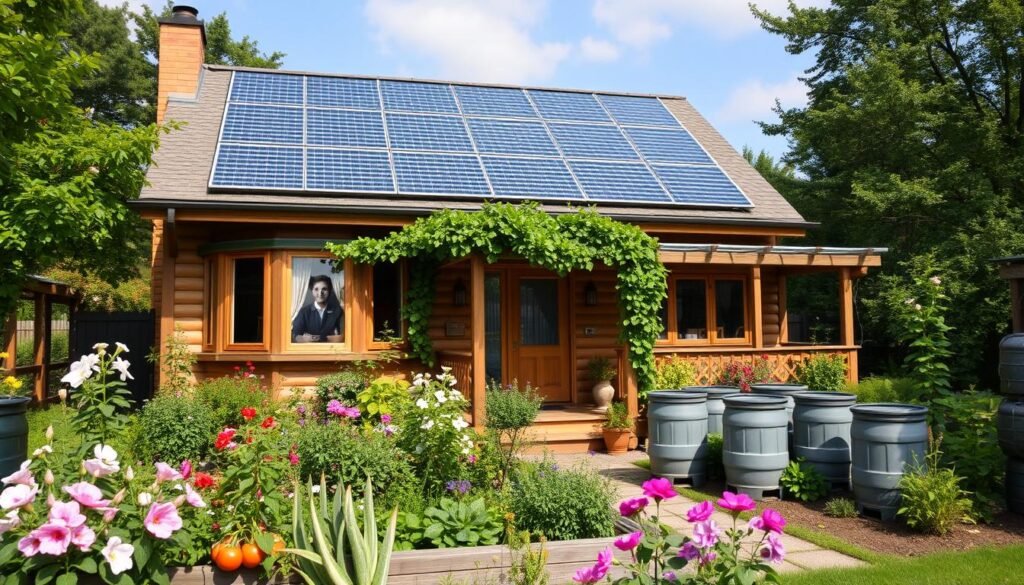
There are many ways to make your home more sustainable. You can go beyond just energy-efficient upgrades. Other green building practices can help reduce your environmental impact and save money.
One good idea is to install a cool roof. It uses unique materials to reflect heat so you use less air conditioning. This can cut down on your energy bills. When upgrading your home using natural materials like bamboo or recycled wood is a good idea. This supports sustainability.
Another smart move is to get a greywater system. It collects water from sinks showers and washing machines. Then it is utilized for things like watering plants or flushing latrines.
Finally consider planting native or adapted plants in your yard. They need less water and care than regular lawns. This makes your home look better and helps the environment by using less water.
By trying these eco-friendly home improvements sustainable home upgrades and green building practices you can make your home more energy-efficient and water-smart.
| Eco-Friendly Home Improvement | Potential Benefits |
|---|---|
| Cool Roof | Reduced energy consumption lowers utility bills |
| Natural/Renewable Building Materials | Sustainable environmentally friendly construction |
| Grey Water System | Reduced freshwater usage water conservation |
| Native/Adapted Landscaping | Lower maintenance water efficiency supports local ecosystems |
Install Energy Star Rated Ceiling Fans
As heat waves become more common finding better cooling options is key. Energy-efficient ceiling fans are a great choice. They cool well help cut down on greenhouse gas emissions and support sustainable cooling.
Efficient Cooling Alternative
Energy Star-rated ceiling fans beat regular fans by 60%. They move warm air in winter and cool air in summer This cuts down on air conditioning use and can lower electricity bills by 30 40%.
Reduce Greenhouse Gas Emissions
utilizing energy-productive roof fans can extraordinarily bring down your carbon impression and assist with decreasing ozone-depleting substance emanations utilizing less energy. Makes your house more eco-accommodating and upholds practical residing.
| Feature | Benefit |
|---|---|
| Energy Efficient Motors | Reduce power draw by up to 90% compared to standard models |
| LED Lighting | utilize something like 80% less energy than radiant bulbs and last quite a bit longer. |
| Sustainable Materials | Bamboo reclaimed wood and recycled aluminum/plastics reduce environmental impact |
| Adjustable Speeds | 3 4 speed settings allow for customized airflow and energy savings |
| Remote Controls | Enable users to adjust to improve energy efficiency |
Switching to Energy Star-rated ceiling fans means better cooling lower bills and less carbon.
Consider Switching to Solar Power
Switching to solar power is a popular choice. Solar panels use the sun as energy reducing pollution and saving water.
A downward trend in the cost of solar panels was noted alongside an upward trend in the quality of the panels.
Renewable Energy Source
It turns sunlight into electricity letting homeowners make their own power which cuts down on pollution and saves money over time.
Long-Term Cost Savings
Getting solar panels costs about $16000 upfront. However the savings in energy can cover this cost in 10 years. It is a good choice for those who stay in their homes long term.
Choosing solar power makes homes more sustainable and energy efficient. It offers many benefits including saving money and helping the environment. Solar power is an excellent option for those who care about the planet.
Conclusion
This article has looked at many ways to make homes more eco-friendly. Simple changes like using LED lights help a lot. More giant steps like adding solar panels also make a big difference.
These changes help the environment and save money in the long run. Homeowners can also get help from government programs.
Creating an eco-friendly home is about using smart tech and making energy-saving changes. It is also about living in a good way for the planet. By doing this homeowners help the environment and improve the homes for their families.
FAQ Eco-Friendly Home Improvements top tips to try
What are the benefits of getting solar panels installed?
Solar panels cut down on pollution and save water. They are getting cheaper and can pay for themselves in 10 years. They are a smart investment in clean energy.
How can Energy Star-rated ceiling fans help reduce greenhouse gas emissions?
Energy Star fans cool efficiently. They use less energy than old fans. This helps reduce greenhouse gases and saves money.
What other eco-friendly home improvement tips are mentioned in the article?
The article suggests cool roofs and natural materials. It also talks about greywater systems and native landscaping.
What should homeowners consider when purchasing new appliances?
Look for Energy Star appliances. They use less energy. Using smaller appliances and covering pans also helps save energy.
How can updating plumbing fixtures help conserve water?
New toilets use less water. WaterSense toilets can save up to 60% of water.
What are some simple and inexpensive eco-friendly home improvements to try?
Many simple swaps can make a big difference. For example switching to LED bulbs is quick and easy. It is a small change that can save a lot of energy.
